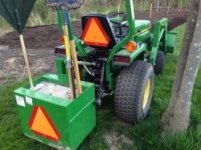WinterDeere
Elite Member
Hey folks,
I just upgrade to a new tractor (from JD 855 to JD 3033R), and am figuring how to best set it up for my use. In hindsight, I may have been better off with the 2032R I was originally contemplating, for my intended use, but here we are...
The new 320R loader specifies the following ballast on this machine:
Six wheel weights
+ filled rear tires
+ 1100 lb. ballast box on 3-point
Even thought the wheel weights for this machine are really 110 lb., the manual states these weight calculations are based on a 60 lb. weight, and the filled tires are based on 11.2-24 @ 3.5 lb/gal = 237 lb. per tire. So, we’re looking at ~714 lb. combined with liquid and iron on the wheels + 1100 lb. in a ballast box. This would put the machine at 3600 lb. without loader and box, and maybe 5400 lb. with loader and box, as no one really seems to know what this loader weighs.
I already have a ballast box, but it’s the standard short box, configured for my old tractor at about 700 lb. Likely not suitable for this new machine, or at least not to spec.
My uses for this machine don’t include mowing, but they do include a lot of other travel across my lawn, including tasks like fertilizing and aerating. This is in addition to heavier tasks like moving firewood (skidding logs = 1000 - 2500 lb.) and plowing the driveway. The usual jack of all trades stuff, but with possible more emphasis on lawn use than most.
So, I’m wondering what to do, here. I’ve been going back and forth in my mind, between just following the spec with RimGuard and a starter weight + one 110 lb. weight in each wheel, and building a new 1100 lb. ballast box, versus something less. My very frequent (maybe even primary) use on the lawn has me wanting to limit how much permanent weight I hang on this machine, but given I tipped my old tractor up on it’s front wheels a few times with a much lighter loader while skidding logs or doing other heavier work, and the fact that I have two kids coming up who may be using this tractor in the future, I’m also seeing the benefit of going full-spec.
What have you guys with similar usage profiles done on your own machines?
One last note, I do have a property with a lot of small slopes, some around the house a little steep. I’m often doing work that requires me to travel sideways to the slope, even when carrying a load in the bucket. For this reason, a very heavy ballast box on its own, which may have a relatively high center of gravity, may not be the best solution.
I just upgrade to a new tractor (from JD 855 to JD 3033R), and am figuring how to best set it up for my use. In hindsight, I may have been better off with the 2032R I was originally contemplating, for my intended use, but here we are...
The new 320R loader specifies the following ballast on this machine:
Six wheel weights
+ filled rear tires
+ 1100 lb. ballast box on 3-point
Even thought the wheel weights for this machine are really 110 lb., the manual states these weight calculations are based on a 60 lb. weight, and the filled tires are based on 11.2-24 @ 3.5 lb/gal = 237 lb. per tire. So, we’re looking at ~714 lb. combined with liquid and iron on the wheels + 1100 lb. in a ballast box. This would put the machine at 3600 lb. without loader and box, and maybe 5400 lb. with loader and box, as no one really seems to know what this loader weighs.
I already have a ballast box, but it’s the standard short box, configured for my old tractor at about 700 lb. Likely not suitable for this new machine, or at least not to spec.
My uses for this machine don’t include mowing, but they do include a lot of other travel across my lawn, including tasks like fertilizing and aerating. This is in addition to heavier tasks like moving firewood (skidding logs = 1000 - 2500 lb.) and plowing the driveway. The usual jack of all trades stuff, but with possible more emphasis on lawn use than most.
So, I’m wondering what to do, here. I’ve been going back and forth in my mind, between just following the spec with RimGuard and a starter weight + one 110 lb. weight in each wheel, and building a new 1100 lb. ballast box, versus something less. My very frequent (maybe even primary) use on the lawn has me wanting to limit how much permanent weight I hang on this machine, but given I tipped my old tractor up on it’s front wheels a few times with a much lighter loader while skidding logs or doing other heavier work, and the fact that I have two kids coming up who may be using this tractor in the future, I’m also seeing the benefit of going full-spec.
What have you guys with similar usage profiles done on your own machines?
One last note, I do have a property with a lot of small slopes, some around the house a little steep. I’m often doing work that requires me to travel sideways to the slope, even when carrying a load in the bucket. For this reason, a very heavy ballast box on its own, which may have a relatively high center of gravity, may not be the best solution.
